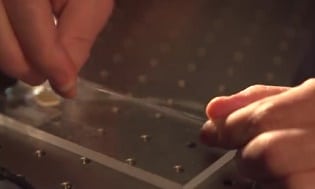Tiny fibers developed at EPFL made from elastomer can incorporate materials such as electrodes and nanocomposite polymers which can detect the slightest strain and pressure while withstanding deformation close to 500% before recovering initial shape, making them ideal for applications in smart clothing, prostheses, and creating artificial nerves for robots.
Thermal drawing process was used to make the fibers starting by creating a macroscopic preform with carious fiber component arranged in a 3D pattern, the preform was heated and stretched out to make fibers of a few hundred microns in diameter. While being stretched out lengthwise the process also contracted crosswise, end result being a set of fibers extremely complicated microarchitecture and advanced properties.
Up until now thermal drawing was only used to make rigid fibers. Thermoplastic elastomers were identified with high viscosity when heated to create elastic fibers, after being drawn the fibers can be stretched and manipulated to other forms, but always return to original shape. Nanocomposite polymers, thermoplastics, and metals can be introduced into the fibres such as different electrodes that come into contact depending on how pressure is applied causing the electrodes to transmit signals.
The fibers have been integrated into robotic fingers to serve as artificial nerves; as the robot fingers touch items electrodes in the fibers transmit information regarding tactile interaction with the environment.
The technology could be used to develop touch keyboards integrated directly onto clothing among many other potential applications. Thermal drawing process can be tweaked for large scale production, making it a plus for manufacturing. Interest has already expressed by textile sectors in regards to this new technology, patents have been filed.




